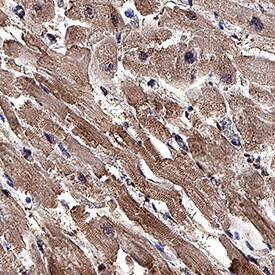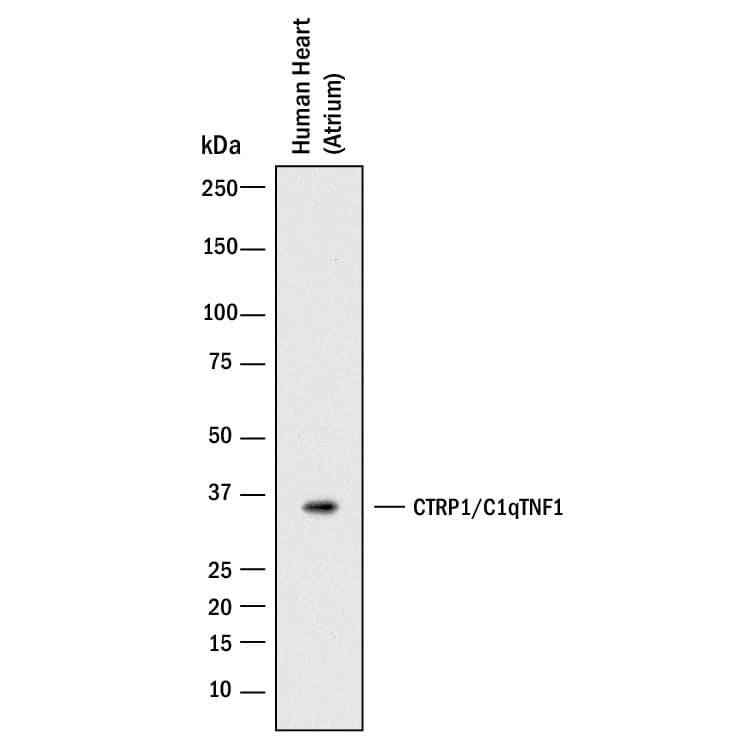Human CTRP1/C1qTNF1 Antibody
R&D Systems, part of Bio-Techne | Catalog # MAB10445

Key Product Details
Species Reactivity
Human
Applications
Immunohistochemistry, Western Blot
Label
Unconjugated
Antibody Source
Monoclonal Mouse IgG2B Clone # 395520
Product Specifications
Immunogen
Mouse myeloma cell line NS0-derived human CTRP1/C1qTNF1
Arg26-Pro281
Accession # Q9BXJ1
Arg26-Pro281
Accession # Q9BXJ1
Specificity
Detects human CTRP1/C1qTNF1 in direct ELISAs.
Clonality
Monoclonal
Host
Mouse
Isotype
IgG2B
Scientific Data Images for Human CTRP1/C1qTNF1 Antibody
Detection of Human CTRP1/C1qTNF1 by Western Blot.
Western blot shows lysates of human heart (atrium) tissue. PVDF membrane was probed with 2 µg/mL of Mouse Anti-Human CTRP1/C1qTNF1 Monoclonal Antibody (Catalog # MAB10445) followed by HRP-conjugated Anti-Mouse IgG Secondary Antibody (Catalog # HAF018). A specific band was detected for CTRP1/C1qTNF1 at approximately 35 kDa (as indicated). This experiment was conducted under reducing conditions and using Immunoblot Buffer Group 1.CTRP1/C1qTNF1 in Human Heart.
CTRP1/C1qTNF1 was detected in immersion fixed paraffin-embedded sections of human heart using Mouse Anti-Human CTRP1/C1qTNF1 Monoclonal Antibody (Catalog # MAB10445) at 1 µg/mL for 1 hour at room temperature followed by incubation with the Anti-Mouse IgG VisUCyte™ HRP Polymer Antibody (Catalog # VC001). Before incubation with the primary antibody, tissue was subjected to heat-induced epitope retrieval using Antigen Retrieval Reagent-Basic (Catalog # CTS013). Tissue was stained using DAB (brown) and counterstained with hematoxylin (blue). Specific staining was localized to sarcoplasm in cardiomyocytes. View our protocol for IHC Staining with VisUCyte HRP Polymer Detection Reagents.Applications for Human CTRP1/C1qTNF1 Antibody
Application
Recommended Usage
Immunohistochemistry
1-25 µg/mL
Sample: Immersion fixed paraffin-embedded sections of human heart
Sample: Immersion fixed paraffin-embedded sections of human heart
Western Blot
2 µg/mL
Sample: Human heart (atrium) tissue
Sample: Human heart (atrium) tissue
Formulation, Preparation, and Storage
Purification
Protein A or G purified from hybridoma culture supernatant
Reconstitution
Reconstitute at 0.5 mg/mL in sterile PBS. For liquid material, refer to CoA for concentration.
Formulation
Lyophilized from a 0.2 μm filtered solution in PBS with Trehalose. *Small pack size (SP) is supplied either lyophilized or as a 0.2 µm filtered solution in PBS.
Shipping
Lyophilized product is shipped at ambient temperature. Liquid small pack size (-SP) is shipped with polar packs. Upon receipt, store immediately at the temperature recommended below.
Stability & Storage
Use a manual defrost freezer and avoid repeated freeze-thaw cycles.
- 12 months from date of receipt, -20 to -70 °C as supplied.
- 1 month, 2 to 8 °C under sterile conditions after reconstitution.
- 6 months, -20 to -70 °C under sterile conditions after reconstitution.
Background: CTRP1/C1qTNF1
References
- Grebrehiwet, B. et al. (2012) Front. Immunol. 5:3.
- Seldin, M.M. et al. (2014) Rev. Endocr. Metab. Disord. 15:111.
- Kim, K.-Y. et al. (2006) FEBS Lett. 580:3953.
- Jeon, J.H. et al. (2008) FASEB J. 22:1502.
- Xin, Y. et al. (2014) Endocr. J. 61:841.
- Peterson, J. M. et al. (2012) J. Biol. Chem. 287:1576.
- Wang, X.Q. et al. (2016) Atherosclerosis 250:38.
- Lu, L. et al. (2016) Eur. Heart J. 37:1762.
- Yuasa, D. et al. (2016) FASEB J. 30:1065.
- Han, S. et al. (2016) J. Nutr. Biochem. 27:43.
- Akiyama, H. et al. (2013) Mol. Cell. Endocrinol. 369:63.
- Bolliger, M.F. et al. (2011) Proc. Natl. Acad. Sci. USA 108:2534.
Long Name
C1q And Tumor Necrosis Factor Related Protein 1
Alternate Names
C1qTNF1, ZSIG37
Gene Symbol
C1QTNF1
UniProt
Additional CTRP1/C1qTNF1 Products
Product Documents for Human CTRP1/C1qTNF1 Antibody
Product Specific Notices for Human CTRP1/C1qTNF1 Antibody
For research use only
